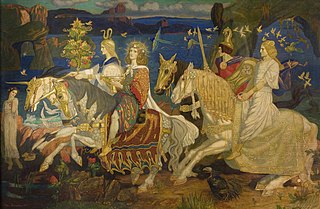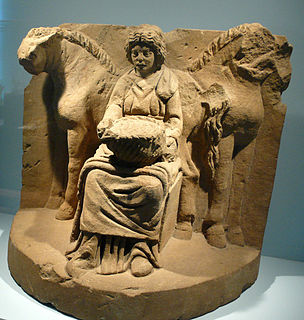
In Gallo-Roman religion, Cernunnos was a deity depicted with antlers, seated cross-legged, and is associated with stags, horned serpents, dogs, bulls, and rats. He is usually holding or wearing a torc and has been seen holding a bag of coins and a cornucopia. Believed to have originally been a Celtic deity, over 50 examples have been found from this time believed to be associated with him, concentrating in the north-eastern region of what was called Gaul by the ancient Romans. Cernunnos is also associated with the Wiccan Horned God in the modern religious tradition of Wicca.

The Tuath(a) Dé Danann, also known by the earlier name Tuath Dé, are a supernatural race in Irish mythology. They are thought to represent the main deities of pre-Christian Gaelic Ireland. The Tuatha Dé Danann constitute a pantheon whose attributes appeared in a number of forms throughout the Celtic world.

Mercury is a major god in Roman religion and mythology, being one of the 12 Dii Consentes within the ancient Roman pantheon. He is the god of financial gain, commerce, eloquence, messages, communication, travelers, boundaries, luck, trickery, and thieves; he also serves as the guide of souls to the underworld.

Erecura or Aerecura was a goddess worshipped in ancient times, often thought to be Celtic in origin, mostly represented with the attributes of Proserpina and associated with the Roman underworld god Dis Pater, as on an altar from Sulzbach. She appears with Dis Pater in a statue found at Oberseebach, Switzerland, and in several magical texts from Austria, once in the company of Cerberus and once probably with Ogmios. A further inscription to her has been found near Stuttgart, Germany. Besides her chthonic symbols, she is often depicted with such attributes of fertility as the cornucopia and apple baskets. She is believed to be similar to Greek Hecate, while the two goddesses share similar names. She is depicted in a seated posture, wearing a full robe and bearing trays or baskets of fruit, in depictions from Cannstatt and Sulzbach. Miranda Green calls Aericura a "Gaulish Hecuba", while Noémie Beck characterizes her as a "land-goddess" sharing both underworld and fertility aspects with Dis Pater.
Alisanos was a local Gallo-Roman god worshipped in what is now the Côte-d'Or in Burgundy and at Aix-en-Provence.
Lleu Llaw Gyffes is a hero of Welsh mythology. He appears most prominently in the Fourth Branch of the Mabinogi, the tale of Math fab Mathonwy, which tells the tale of his birth, his marriage, his death, his resurrection and his accession to the throne of Gwynedd. He is a warrior and magician, invariably associated with his uncle Gwydion.
In Gallo-Roman religion, Arduinna was the eponymous tutelary goddess of the Ardennes Forest and region, thought to be represented as a huntress riding a boar. Her cult originated in the Ardennes region of present-day Belgium, Luxembourg, and France. She was identified with the Roman goddess Diana.
Borvo or Bormo was an ancient Celtic god of healing springs worshipped in Gauls and Gallaecia. He was sometimes identified with the Graeco-Roman god Apollo, although his cult have preserved a high degree of autonomy during the Roman period.
Ogma is a god from Irish and Scottish mythology. A member of the Tuatha Dé Danann, he is often considered a deity and may be related to the Gallic god Ogmios. According to the Ogam Tract, he is the inventor of Ogham, the script in which Irish Gaelic was first written.

Esus, Hesus, or Aisus was a Gaulish god known from two monumental statues and a line in Lucan's Bellum civile.

The Lingones were a Gallic tribe of the Iron Age and Roman periods. They dwelled in the region surrounding the present-day city of Langres, between the provinces of Gallia Lugdunensis and Gallia Belgica.

The Gundestrup cauldron is a richly decorated silver vessel, thought to date from between 200 BC and 300 AD, or more narrowly between 150 BC and 1 BC. This places it within the late La Tène period or early Roman Iron Age. The cauldron is the largest known example of European Iron Age silver work. It was found dismantled, with the other pieces stacked inside the base, in 1891 in a peat bog near the hamlet of Gundestrup in the Aars parish of Himmerland, Denmark. It is now usually on display in the National Museum of Denmark in Copenhagen, with replicas at other museums; during 2015–16 it was in the UK on a travelling exhibition called The Celts.
In Celtic mythology, the Otherworld is the realm of the deities and possibly also of the dead. In Gaelic and Brittonic mythology it is usually described as a supernatural realm of everlasting youth, beauty, health, abundance and joy. The Otherworld is similar to the parallel universe, usually elusive, but various mythical heroes visit it either through chance or after being invited by one of its residents. They often reach it by entering ancient burial mounds or caves, or by going under water or across the western sea. Sometimes, the Otherworld is said to exist alongside our own located beyond the edge of the earth and intrudes into our world; signalled by phenomena such as magic mist, sudden changes in the weather, or the appearance of divine beings or unusual animals. An otherworldly woman may invite the hero into the Otherworld by offering an apple or a silver apple branch, or a ball of thread to follow as it unwinds.

Ancient Celtic religion, commonly known as Celtic paganism, comprises the religious beliefs and practices adhered to by the Iron Age people of Western Europe now known as the Celts, roughly between 500 BCE and 500 CE, spanning the La Tène period and the Roman era, and in the case of the Insular Celts the British and Irish Iron Age. Very little is known with any certainty about the subject, and apart from documented names, which are thought to be of deities, the only detailed contemporary accounts are by hostile Roman writers, who were probably not well-informed.

In Celtic mythology, Ecne was one of the Tuatha Dé Danann and was the god of wisdom, or knowledge.
According to classical sources, the ancient Celts were animists. They honoured the forces of nature, saw the world as inhabited by many spirits, and saw the Divine manifesting in aspects of the natural world.

The gods and goddesses of the pre-Christian Celtic peoples are known from a variety of sources, including ancient places of worship, statues, engravings, cult objects and place or personal names. The ancient Celts appear to have had a pantheon of deities comparable to others in Indo-European religion, each linked to aspects of life and the natural world. By a process of syncretism, after the Roman conquest of Celtic areas, these became associated with their Roman equivalents, and their worship continued until Christianization. Pre-Roman Celtic art produced few images of deities, and these are hard to identify, lacking inscriptions, but in the post-conquest period many more images were made, some with inscriptions naming the deity. Most of the specific information we have therefore comes from Latin writers and the archaeology of the post-conquest period. More tentatively, links can be made between ancient Celtic deities and figures in early medieval Irish and Welsh literature, although all these works were produced well after Christianization.
Artaius is a Celtic epithet applied to the Roman god Mercury during the Romano-Celtic period. It is known from a single inscription from Beaucroissant in the Isère:

Celtic is the mythology of Celtic polytheism, the religion of the Iron Age Celts. Like other Iron Age Europeans, the early Celts maintained a polytheistic mythology and religious structure. For Celts in close contact with Ancient Rome, such as the Gauls and Celtiberians, their mythology did not survive the Roman Empire, their subsequent conversion to Christianity and the loss of their Celtic languages. It is mostly through contemporary Roman and Christian sources that their mythology has been preserved. The Celtic peoples who maintained either political or linguistic identities left vestigial remnants of their ancestral mythologies that were put into written form during the Middle Ages.











